
Introduction
Solid state drives (SSDs) are gaining popularity as storage devices due to their speed, durability, and compact size. However, like any storage media, SSDs are still susceptible to data loss due to deletion, corruption, or physical damage. Recovering data from a damaged SSD can be very challenging compared to traditional hard disk drives. In this article, I will discuss the unique challenges of SSD data recovery and provide an overview of potential solutions.
Challenges of SSD Data Recovery
SSDs store data differently than traditional hard drives, which poses unique challenges for data recovery:
Trim Operations
Many SSDs perform an automatic “trim” operation, which permanently deletes unused blocks of data. This makes recovering trimmed data nearly impossible.
Wear Leveling
SSDs use wear leveling algorithms that continuously move data around to ensure even usage and increase lifespan. This makes locating specific files and data more difficult.
Limited Window for Recovery
SSDs store data in NAND flash memory chips. When these chips fail, data will quickly deteriorate as charge leaks away. This gives a limited window to recover data before it is lost forever.
Lack of Mechanical Parts
The absence of moving parts in SSDs eliminates the possibility of mechanical failure recovery techniques used for hard disk drives.
Proprietary Technology
Most SSDs use proprietary technologies not disclosed to the public, making data recovery more challenging. Wide knowledge of these systems is needed.
Encryption
Many SSDs encrypt all data stored on the drive. Encryption must be disabled or cryptographic keys obtained for successful data recovery.
Solutions for Recovering Data from Damaged SSDs
Despite the challenges, data recovery from damaged SSDs is often possible with the right tools, techniques, and experience:
Logical Recovery Methods
Logical recovery involves interfacing with the SSD’s firmware through available software commands and interfaces. This method can recover deleted files and partitions.
Chip-Off Recovery
The NAND flash memory chips are physically removed from the SSD and read using specialized tools to bypass any firmware encryption or hardware damage.
Microsoldering
Where physical damage has occurred, skilled microsoldering can be used to repair connections and communication between SSD components.
Maintain Proper Environment
A professional cleanroom environment is used to open SSD assemblies and prevent further contamination or damage that could hinder data recovery efforts.
Advanced Imaging
Powerful imaging techniques like scanning electron microscopy can reveal damage and extract raw data from NAND chips.
Bypass Onboard Controller
If the SSD’s controller chip is damaged, specialized adapters can be used to bypass it and read NAND chips directly.
Decryption Capabilities
In-house developed decryption capabilities for popular SSD encryption schemes allow access to data on secured drives.
Invest in Latest Technology
Continuous investment in state-of-the-art tools and research is necessary to keep pace with rapid SSD technological advances.
Choosing a Data Recovery Service
Due to the complexity of SSD data recovery, specialized services are recommended over general computer repair shops. When evaluating a company, ensure they have specific credentials:
- Class 100 cleanroom facilities to safely open and handle SSD internals.
- Experience recovering data from SSDs, including certifications and customer reviews.
- Custom data recovery tools designed for SSDs vs traditional drives.
- Strong R&D to continually update their capabilities as SSD technology progresses.
- Encryption decoding abilities for popular SSD encryption like AES-256, ATC, etc.
- Free evaluations to determine recovery feasibility without upfront payments.
While SSD technology provides many benefits, it also introduces new data recovery challenges. With the right expertise and tools, recovering data from a damaged SSD is very possible. However, always make sure to backup irreplaceable data to limit reliance on recovery services.












